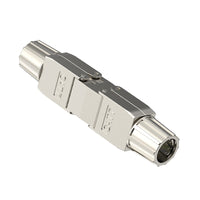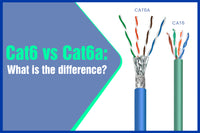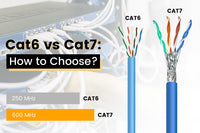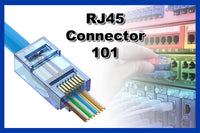With the rapid development of FTTx technology and optical fiber, many people think that Ethernet cables have already been a thing of the past. Things can be different. In the past years, Ethernet cables have continued to develop and the latest development is Cat8 Ethernet cable.
What is Cat8?
Cat8 is the latest category of Ethernet cable officially recognized by the IEEE and EIA, which can be seen as a giant leap in the development of copper wire. The international standard ISO/IEC 11801 defines two classes of Cat8: Class I and Class II. Cat8.1 is compatible with RJ45 connectors, while Cat8.2 is not designed for RJ45 connectors (usually compatible with GG45).
Different from other Ethernet cable categories, Category 8 Ethernet cables are always shielded to reduce crosstalk and noise. Cat8 Ethernet cable has a higher data transmission speed and bandwidth than previous standard of network cables. Cat8 can support 25 Gbps and 40 Gbps at the maximum length of 24 meters (78 feet) and 30 meters (100 feet).
Let’s take a look at the basic specification of Cat8 Ethernet cables and explain the technical terms that are often seen in the cable specifications.

- AWG: American Wire Gauge (AWG) is the standard way to measure wire size in North America. In general, the larger the wire size, the smaller the AWG. For example, a wire rated at 24 AWG is smaller and has less copper than a 22 AWG wire.
- Jacket: This is a layer of insulation that covers the cable to protect it from moisture and chemical and physical impact. Cable jackets usually have different ratings with different protection requirements.
- CM: CM stands for “Communications Multipurpose” cable, which means that the cable is suitable for in-wall installations. CM cable can be regarded as the minimum jacket rating for in-wall applications and it should be approved by Underwriters Laboratories (UL).
- PVC: This is short for “Polyvinyl Chloride”, which is one of the most common cable jacket materials. And it is usually recommended for indoor use.
- S/FTP: Short for shielded with foiled twisted pairs. It means that four twisted pairs are wrapped in foil tape with an overall strong braid screen. The foil on the twisted pairs is designed to further reduce crosstalk and noise.
- Bandwidth: It means the maximum capacity of an Ethernet cable to transmit data in bits per second (Bps).
- OD: Short for “outside diameter”, and it is used to measure the diameter of a cable. When you want to install a home network yourself, it is important to know the OD of a cable, or the cable may not fit the connector.
Cat8 Patch Cable
Cat8 patch cables are pre-wired cables with RJ45 connectors and are suitable for people who don’t like DIY. You just need to directly insert the cable into the place you want. For novices, the Cat8 patch panel is easy and convenient to use. Enterprises don’t need to ask a network professional for help. Cat8 patch cables ensure high speed, stable transmission, and less electromagnetic interference.
Ethernet Cable Comparison
Ethernet cable is an essential part of a LAN cable with a long history. There are many different types of Ethernet cables with different limitations of speed, bandwidth, and distance. You can see Cat5, Cat5e, Cat6, Cat6a, and Cat8 on the market, what about Cat7? Cat7 has not been recognized by EIA/TIA, but it is also provided by many suppliers. Take a look at the following comparison chart and see how is Cat8 different from other category Ethernet cables.
|
Cable Types |
Shielding |
Maximum Bandwidth |
Maximum Speed |
|
CAT5 |
Unshielded or shielded |
100 MHz |
100 Mbps |
|
CAT5E |
Unshielded or shielded |
100 MHz |
1 Gbps |
|
CAT6 |
Unshielded or shielded |
250 MHz |
1 Gbps |
|
CAT6A |
Unshielded or shielded |
500 MHz |
10 Gbps |
|
CAT7 |
Only shielded |
600 MHz |
40 Gbps |
|
CAT8 |
Only shielded |
2,000 MHz |
25 Gbps / 40 Gbps |
PoE
Power over Ethernet (PoE) is a technology that allows Ethernet cables to deliver data and power at the same time. PoE technology helps reduce the cost of installing other electrical cables.
Cat8 Ethernet cables also support PoE technology, which can save space in date centers or server rooms. In addition, it also cuts the cost of cabling installation. But Cat8 cable installation can be a bit more expensive than previous standard cables as Cat8 Ethernet cables have a higher performance.
Is Cat8 Ethernet Cable Good for Gaming?
Of course, you can use Cat8 Ethernet cables for gaming as they can support a bandwidth of up to 2,000 MHz and the maximum speed can reach 25 Gbps or 40 Gbps, but it may be overkilled. As is known to all, latency is very important in gaming. Latency is not only affected by the Ethernet cables but also by your ISP, router, and other network hardware. So even if your Ethernet cable supports a high speed, the ISP and router will limit your Internet speed.

Currently, most home applications work well with Cat6 or Cat6a Ethernet cables, and most home equipment cannot work at the speed of CAT8 Ethernet cables. While Cat8 Ethernet cables are overkill for your online gaming, a wired connection can always be your first choice for gaming. If you want to learn more about the difference between wired and wireless connection, read the article: wired vs wireless network.
But if you are looking for a future-proofing network cable, you’ll never go wrong with Cat8 network cables.
Is Cat8 Worth It?
Is it worth getting a Cat8 Ethernet cable? It depends on your own circumstances. Cat8 Ethernet cables may be unnecessary for your home network, but it is the best choice for data centers and server rooms with requirements for high-speed networks. Cat8 Ethernet cables are compatible with RJ45 connectors, so they can suit most network equipment. If your business needs a speed of more than 10 Gbps, Cat8 Ethernet cables can be the most cost-effective solution to upgrading your network.

With the development of technology, Cat8 Ethernet cables can be more affordable and they can be your excellent option for “future-proofing” networks.
FAQs
Is CAT 8 backward compatible?
CAT 8 uses standard RJ45 connectors, so it is backward compatible with previous-category Ethernet cables.
CAT 7 vs CAT 8, which is better?
The first thing you should consider is that CAT 8 is recognized by TIA/EIA, but CAT 7 has not been approved. And CAT 8 Ethernet cable has a higher performance than CAT 7, so CAT 8 is more recommended for you when upgrading your network.
Will CAT 8 work with any router?
Yes, but actually most home network equipment cannot work at CAT 8 speed.
Is CAT 8 suitable for home networks?
CAT 8 Ethernet cables can be more suitable for data centers and server rooms, but if you have a higher requirement for network speed, CAT8 is future-proofing.
For more information on this topic, you can keep up on our blogs. While VCELINK offers general and basic information for our customers and other visitors to the website, it’s not professional advice.





Be the first one to comment.
Leave a comment